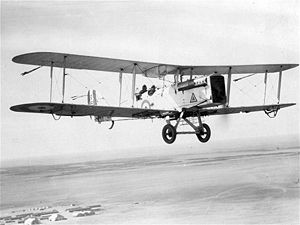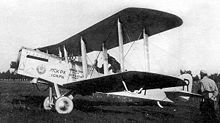Airco DH.9A Video and Picture

|
|
Airco DH.9A
D.H.9A

Picture - Airco D.H.9A
Role: Light bomber/General purpose]
Manufacturer: Airco
First flight: March 1918
Introduced: 1918
Retired: 1931
Primary user: Royal Air Force
Number built: 1997
Developed from: Airco DH.9
Variants: Westland Walrus, de Havilland DH.15
The Airco DH.9A was a British light bomber designed and first used shortly before the end of the First World War. Colloquially known as the "Ninak" (from the designation nine-A), it served on in large numbers for the Royal Air Force following the end of the war, both at home and overseas, where it was used for colonial policing in the Middle East, finally being retired in 1931.
Design and development
The DH.9A was planned as an improved version of the existing Airco DH.9. The DH.9 was a disappointment owing to its underpowered and unreliable engines, and the DH.9A was planned to use much more powerful engines to resolve this. As the Rolls-Royce Eagle engine used in the successful DH.4 was unavailable in sufficient quantities, the new 400 hp (298 kW) American Liberty engine was chosen instead.
As Airco was busy developing the Airco DH.10 twin-engined bomber, detailed design was carried out by Westland Aircraft. The DH.9 was fitted with new, longer span wings, and a strengthened fuselage structure.
The first prototype flew in March 1918, powered by a Rolls-Royce Eagle as no Liberty engines were yet available. The prototype proved successful, with the first Liberty-engined DH.9A flying on 19 April 1918, and deliveries to the Royal Air Force starting in June. By the end of the war, a total of 2,250 DH.9As had been ordered, with 885 having built by the end of the year. As it was decided that the DH.9A would be a standard type in the postwar RAF, the majority of outstanding orders were fulfilled, with 1,730 being built under the wartime contracts before production ceased in 1919.
The United States also planned to adopt the DH.9A as a replacement for the DH.4, placing orders for 4,000 modified aircraft, designated U.S.D-9A. This order was cancelled with the end of the war, however, and only a limited number of prototypes were built.
While the existing aircraft were subject to a programme of refurbishment, a number of small contracts were placed for new production of DH.9As in 1925-26. These contracts resulted in a further 268 DH.9As being built. The new production and refurbished aircraft included batches of dual control trainers and six experimental aircraft powered by 465 hp Napier Lion engines, which reached a maximum speed of 144 mph.
The Soviet Union built large numbers of an unlicenced copy of the DH.9A, the R-1. After the production of 20 DH.4 copies, followed by about 200 copies of the DH.9 powered by the Mercedes D.IV engine (also designated the R-1) and a further 130 powered by the Siddeley Puma (designated R-2), a copy of the DH.9A, powered by the M-5 engine, a Soviet copy of the DH.9A's Liberty entered production in 1924.
Operational history
First World War
The DH.9A entered service in July 1918 with No. 110 Squadron RAF, moving to France to serve with the Independent Air Force on 31 August 1918, and flying its first mission against a German airfield on 14 September 1918. A further three squadrons commenced operations over the Western Front before the Armistice, with 99 Squadron (also serving with the Independent Air Force) replacing DH.9s, while 18 Squadron and 216 Squadron replaced DH.4s. Despite the superior performance of the DH.9A over the DH.9, the DH.9A squadrons suffered high losses during their long range bombing missions over Germany. Other squadrons flew coastal patrols from Great Yarmouth before the end of the year.
The United States Marine Corps also adopted the DH.9A, its Northern Bombing group receiving at least 53, operations starting in September 1918.
Interwar RAF service
While the squadrons in service at the end of the First World War quickly disbanded or re-equipped in the postwar dis-armament, the DH.9A continued in service as the RAF's standard light bomber, with a total of 24 squadrons being equipped between 1920 and 1931, both at home and abroad.
The first post war operations were in southern Russia in 1919, in support of the "White Army" against the Bolsheviks in the Russian Civil War. In September 1919, the RAF personnel were ordered to return home, leaving their aircraft behind. A squadron of DH.9As was deployed to Turkey in response to the Chanak Crisis in 1922, but did not engage in combat.
The DH.9A was one of the key weapons used by Britain to manage the territories that were in its control following the collapse of the Ottoman Empire at the end of the Great War. Five squadrons of DH.9As served in the Middle East, carrying out occasional bombing raids against rebelling tribesmen and villages. A larger radiator was fitted to cope with the high temperatures, while additional water containers and spares (including spare wheels lashed to the fuselage) were carried in case the aircraft were forced down in the desert, the DH.9A's struggling under ever heavier loads. Despite this it served successfully, with the Liberty engine being picked out for particular praise for its reliability ("as good as any Rolls Royce") in such harsh conditions. Some DH.9A aircraft were also transported to India to supplement the British Indian Army.
At home, the DH.9A continued on in regular RAF service until 1930, also forming the initial equipment of the Royal Auxiliary Air Force (RAuxAF).
Soviet service
The R-1 was heavily used by the Soviet Air Forces through the 1920s as its standard light bomber and reconnaissance aircraft. The Soviets deployed R-1s in support of the Chinese Kuomintang forces in the Northern Expedition against warlords in 1926-27 and against Chinese forces in clashes over control of the Chinese Eastern Railway in Manchuria in 1929. R-1s were also used in support of operations against Basmachi Rebels in central Asia.
Variants
Airco DH.9A: Original version.
de Havilland DH.9AJ: Single prototype with Bristol Jupiter engine.
de Havilland DH.9R: Racing aircraft with sesquiplane wing powered by Napier Lion engine - (one built).
Airco DH.15 Gazelle: Re-engined DH.9A with a B.H.P Atlantic inline engine, one conversion
Airco DH.16: Civil transport with widened fuselage seating four passengers in a glazed cabin behind the pilot, who sat in an open cabin, nine built. Rolls Royce Eagle or Napier Lion Engine.
de Havilland DH-49 - proposed modernised version with Eagle IX engine (not built)
Engineering Division USD-9A: United States built version, 13 built.
Engineering Division USD-9B: USD-9A fitted with more powerful Liberty engine.
Armstrong Whitworth Tadpole One prototype conversion for a naval three-seat spotter/reconnaissance aircraft.
Westland Walrus Production version of the Tadpole conversion with the Napier Lion III engine (36 built).

Picture - Polikarpov R-1
Polikarpov R-1 and R-2 Copy of DH.9A built in Soviet Union, originally at Duks Aircraft Works, supervised by Nikolai Nikolaevich Polikarpov. Early aircraft were powered by Mercedes DIV or Armstrong Siddeley Puma, but with most powered by an M-5 copy of the Liberty Engine. Produced 1922-1932, with over 2,400 built.
Polikarpov R-1 BMW: This version of the R-1, was fitted a 240 hp (179 kW) BMW IVa engine, 20 built.
Polikarpov MR-1: Twin-float seaplane version, 124 built.
Polikarpov PM-2: Prototype floatplane fitted with metal floats.
Operators
Afghanistan
Afghan Air Force - Airco DH.9As and Polikarpov R-1s
Australia
Royal Australian Air Force: The RAAF received 28 DH.9As (RAAF serial A6-1 to A6-28). The aircraft were in service from 1920 to 1930.
No. 1 Squadron RAAF
No. 3 Squadron RAAF
No. 1 Flying Training School RAAF
Canada
Royal Canadian Air Force
Iran
Imperial Iranian Air Force
Mongolia
Mongolian People's Air Force : Polikarpov R-1s and R-2s
United Kingdom
Royal Air Force
No. 3 Squadron RAF
No. 8 Squadron RAF
No. 11 Squadron RAF
No. 14 Squadron RAF
No. 15 Squadron RAF
No. 18 Squadron RAF
No. 22 Squadron RAF
No. 24 Squadron RAF
No. 25 Squadron RAF
No. 30 Squadron RAF
No. 39 Squadron RAF
No. 45 Squadron RAF
No. 47 Squadron RAF
No. 55 Squadron RAF
No. 60 Squadron RAF
No. 84 Squadron RAF
No. 99 Squadron RAF
No. 100 Squadron RAF
No. 110 Squadron RAF
No. 205 Squadron RAF
No. 207 Squadron RAF
No. 207 Squadron RAF
No. 221 Squadron RAF
No. 273 Squadron RAF
No. 501 Squadron RAF
No. 600 Squadron RAF
No. 601 Squadron RAF
No. 602 Squadron RAF
No. 603 Squadron RAF
No. 604 Squadron RAF
No. 605 Squadron RAF
United States
United States Marine Corps
Soviet Union
Soviet Air Force : Polikarpov R-1s and R-2s
Specifications (DH.9A)
Data from The British Bomber since 1914
General characteristics
Crew: 2
Length: 30 ft 3 in (9.22 m)
Wingspan: 45 ft 11¾ in (14.02 m)
Height: 11 ft 4 in (3.46 m)
Wing area: 486.75 ft² (45.2 m²)
Empty weight: 2,800 lb (1,272 kg)
Max takeoff weight: 4,645 lb (2,111 kg)
Powerplant: 1x— Liberty 12A V-12 piston, 400 hp (298 kW)
Performance
Maximum speed: 123 mph (198 km/h)
Service ceiling: 16,750 ft (5,110 m)
Endurance: 5¼ hours
Climb to 10,000 ft: 15 min 45sec
Armament
Forward firing Vickers machine gun
1 or 2 Rear Lewis guns on scarff ring
Up to 740 lb (336 kg) bombs on underwing and fuselage racks
Related development
Airco DH.9
Westland Wapiti
Westland Wallace
Bibliography
Alexandrov, Andrei and Gennady Petrov. "Aah! De Havilland-Ski!:Origins and Development of the R-1, the Soviet DH.9A". Air Enthusiast, Number 74, March/April 1998. Stamford, UK: Key Publishing, pp. 54-63. ISSN 0143-5450.
Bowyer, Chaz. "de Havilland D.H.9A (RAF: 1918-30)". Aircraft in Profile, Volume 14. Windsor, Berkshire, UK: Profile Publications Ltd., 1974, pp. 25-49. ISBN 0-35383-023-1.
Bruce, J.M. "The De Havilland D.H.9A: Historic Military Aircraft No.13, Part I". Flight, 25 May 1956, pp. 641-644.
Bruce, J.M. "The De Havilland D.H.9A: Historic Military Aircraft No.13, Part II". Flight, 1 June 1956, pp. 677-680.
Donald, David, ed. The Encyclopedia of World Aircraft. London: Aerospace Publishing, 1997. ISBN 1-85605-375-X.
Gunston, Bill. The Osprey Encyclopedia of Russian Aircraft from 1875 - 1995. London: Osprey Aerospace, 1995. ISBN 1-85532-405-9.
Jackson, A.J. De Havilland Aircraft since 1909. London: Putnam, Third edition, 1987. ISBN 0-85177-802-X.
Mason, Francis K. The British Bomber since 1914. London: Putnam Aeronautical Books, 1994. ISBN 0-85177-861-5.
Thetford, Owen. "By Day and By Night: Part 3". Aeroplane Monthly, August 1992, Vol. 20, No. 8, Issue No. 232. London: IPC. pp. 16-22. ISSN 0143-7240.
Williams, George K. Biplanes and Bombsights: British Bombing in World War I. Maxwell Air Force Base, Alabama: Air University Press, 1999. ISBN 1-41020-012-4.
Living Warbirds: The best warbirds DVD series.
Source: WikiPedia